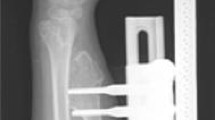Abstract
Fourteen wrists in 11 girls, mean age 13.3 years (range 9–16) at surgery, were treated for Madelung’s deformity. The presenting complaint was incapacitating pain. All were treated by radial closing wedge osteotomy and ulnar shortening osteotomy. The dorsal retinaculum was also surgically repaired in six cases. At a mean follow-up of 5.1 years (range 4–8.75), we observed improved range of motion in both flexion/extension and pronation/supination and absence of pain during daily activity. Radiographically, positioning of the distal radial articular surface and lunate subsidence were improved. Union was obtained after all osteotomies without secondary procedures. Posterior displacement of the ulnar head persisted in two wrists. Combined radioulnar osteotomy restored the anatomy to as near normal as possible. This technique provides satisfactory and encouraging results and does not compromise the surgical future of the wrist. However, longer follow-up is required to assess recurrence or possible long-term degenerative consequences.
Resumé
Quatorze poignets chez 11 filles d’âge moyen 13,3 ans (9–16) à la chirurgie, ont été traités pour une déformation de Madelung. La douleur était la plainte principale. Tous les patients ont bénéficié d’une ostéotomie cunéiforme radiale de fermeture associée à un raccourcissement de l’ulna. Une plastie du retinaculum dorsal a été associée dans 6 cas. Au recul moyen de 5,1 ans (4–8,75), nous avons observé une amélioration des amplitudes articulaires aussi bien en flexion/extension qu’en pronation/supination avec absence de douleur lors des activités quotidiennes. Radiographiquement, l’orientation de la glène radiale ainsi que la subsidence du lunatum ont été améliorées. Toutes les ostéotomies ont consolidé en première intention dans des délais normaux. Un déplacement postérieur de la tête ulnaire persistait dans 2 cas. L’ostéotomie combinée radio-ulnaire permet de restaurer une anatomie le plus proche de la normale. Cette technique offre des resultants satisfaisants et encourageants et ne compromet pas le devenir chirurgical de ces poignets. Cependant, des études avec un plus long recul sont nécessaires afin de rechercher d’éventuelles récidives ou de possibles conséquences dégénératives à plus long terme.







Similar content being viewed by others
References
Aharoni C, Glard Y, Launay F, Gay A, Legré R (2006) Maladie de Madelung: ostéotomie isolée de l’ulna. Chir Main 25:309–314
Angelini LC, Leite VM, Faloppa F (1996) Surgical treatment of Madelung disease by the Sauvé-Kapandji technique. Ann Chir Main Memb Super 15:257–264
Bruno RJ, Blank JE, Ruby LK, Cassidy C, Cohen G, Bergfield TG (2003) Treatment of Madelung’s deformity in adults by ulna reduction osteotomy. J Hand Surg [Am] 28:421–426
Cook PA, Yu JS, Wiand W, Lubbers L, Coleman CR, Cook AJ 2nd, Kean JR, Cook AJ (1996) Madelung deformity in skeletally immature patients: morphologic assessment using radiography, CT, and MRI. J Comput Assist Tomogr 20:505–511
Dagrégorio G, Saint-Cast Y (2005) Réorientation de la glène radiale dans la déformation de Madelung par ostéotomie cunéiforme avec retournement. Chir Main 24:109–112
De Smet L, Moens P, Fabry G (1996) Traitement chirurgical de la déformation de Madelung: analyse d’une série et proposition d’un protocole de traitement. Acta Orthop Belg 62:133–136
dos Reis FB, Katchburian MV, Faloppa F, Albertoni WM, Laredo Filho J Jr (1998) Osteotomy of the radius and ulna for the Madelung deformity. J Bone Joint Surg Br 80:817–824
Felman AH, Kirkpatrick JA (1969) Madelung’s deformity: observations in 17 patients. Radiology 93:1037–1042
Flatt AE (1977) The care of congenital hand anomalies. CV Mosby, St Louis
Golding JS, Blackburne JS (1976) Madelung’s disease of the wrist and dyschondrosteosis. J Bone Joint Surg Br 58:350–352
Harley BJ, Brown C, Cummings K, Carter PR, Ezaki M (2006) Volar ligament release and distal radius dome osteotomy for correction of Madelung’s deformity. J Hand Surg [Am] 31:1499–1506
Houshian S, Schrøder HA, Weeth R (2004) Correction of Madelung’s deformity by the Ilizarov technique. J Bone Joint Surg Br 86:536–540
Mansat M, Lebarbier P, Cahuzac JP, Gay R, Pasquie M (1979) La maladie de Madelung. A propos de neuf cas opérés. Ann Chir 33:669–675
Martini-Benkeddache Y, Benslama R (1979) Réflexions sur les indications thérapeutiques dans la maladie de Madelung. Ann Chir: 677–681
McCarroll HR Jr, James MA, Newmeyer WL 3rd, Molitor F, Manske PR (2005) Madelung’s deformity: quantitative assessment of X-ray deformity. J Hand Surg [Am] 30:1211–1220
Murphy M, Linscheid R, Dobyns JH, Peterson HA (1996) Radial opening wedge osteotomy in Madelung’s deformity. J Hand Surg [Am] 21:1035–1044
Nielsen JB (1977) Madelung’s deformity. A follow-up study of 26 cases and a review of the literature. Acta Orthop Scand 48:379–384
Ranawat CS, DeFiore J, Straub LR (1975) Madelung’s deformity. An end-result study of surgical treatment. J Bone Joint Surg Am 57:772–775
Salon A, Serra M, Pouliquen JC (2000) Long-term follow-up of surgical correction of Madelung’s deformity with conservation of the distal radioulnar joint in teenagers. J Hand Surg [Br] 25:22–25
Schmidt-Rohlfing B, Schwöbel B, Pauschert R, Niethard FU (2001) Madelung deformity: clinical features, therapy and results. J Pediatr Orthop B 10:344–348
Van Demark RE Sr, Van Demark RE Jr (1993) Long-term results after the surgical treatment of Madelung’s deformity: a case report. J Hand Surg [Am] 18:1008–1011
Vickers D, Nielsen G (1992) Madelung deformity: surgical prophylaxis (physiolysis) during the late growth period by resection of the dyschondrosteosis lesion. J Hand Surg [Br] 17:401–407
White GM, Weiland AJ (1987) Madelung’s deformity: treatment by osteotomy of the radius and Lauenstein procedure. J Hand Surg [Am] 12:202–204
Author information
Authors and Affiliations
Corresponding author
Rights and permissions
About this article
Cite this article
Laffosse, JM., Abid, A., Accadbled, F. et al. Surgical correction of Madelung’s deformity by combined corrective radioulnar osteotomy: 14 cases with four-year minimum follow-up. International Orthopaedics (SICOT) 33, 1655–1661 (2009). https://doi.org/10.1007/s00264-008-0711-z
Received:
Revised:
Accepted:
Published:
Issue Date:
DOI: https://doi.org/10.1007/s00264-008-0711-z




